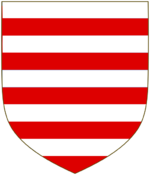House of Goëtzën
 | |
| Country | |
|---|---|
| Titles | Archduke of Karnia Prince of Ruthenia Prince Hohenstenberg Count of Bihar Count Götzö |
| Founder | Matthias Götzö |
| Current head | Oscar I, Emperor-King of Karnia-Ruthenia |
| Founding | c. 1840 |
| Cadet branches | Götzö-Thomaz-Rocha |
| Ethnicity | Hungarian, German, Russian, Pole |
The House of Götzö (Portuguese: Casa de Götzö, Hungarian: Götzö-ház, German: Haus Goëtzën) is a noble family, macronationally connected to the Hungarian nobility and micronationally connected to the Kingdom of Ruthenia, Karnia-Ruthenia and the Occidian Empire. An Hungarian family from Biharkeresztes, the family immigrated to Brazil following the defeat of Austria-Hungary on World War I. The family settled in São Paulo were they have remained to this day.
The last member of the family is the Oscar I, son of the last living member of the family in female line, the Archduchess Denise of Karnia-Ruthenia. The last member of male line, Wladimir von Goëtzën, older brother of Archduchess Denise, died without issue in 1990's.
History

The House of Götzö officially states since the late XIX century they descended from the line of Attila[1], King and chieftain of the Hunnic Empire and that have a close connection to the House of Árpád.
In fact, the first verified ancestor of the house is shared with the Arpads, Ügyek, Chieftain of Scythia. In any case, studying the other relations of the family, other interesting characters appears, as Rudolf of Rheinfelden, the first anti-king in the history of the Holy Roman Empire, Manuel Erotikos Komnenos, ancestor of the Komnenos dynasty, Rurik, Prince of Ladoga and Novgorod and founder of the House of Rurik and Chościsko, Duke of the Polans and founder of the House of Piast.

Despite the royal connections, the family always belonged to lower nobility, never possessing any other title higher then count and always being attached to the Hungarian Crown, serving from Stephen I of Hungary to Charles IV of Hungary - first and last Kings of Hungary. This notable achievement was highlighted with two of the ancestors of the house serving as Palatine of Hungary from 1275 to 1283, the highest-ranking office in the Kingdom of Hungary, representatives of the monarchs. Thier power eventually faded, but supported the Austro-Hungarian Compromise of 1867 and the Habsburgs through the First World War and after the war, during the Easter Crisis and the March on Budapest. After the failure of the attempts to restore the Habsburgs, the family left Hungary in 1921 and never returned. They settled in São Paulo, Brazil.

In November 2014, a cognate member of the house, Oscar I, founded the Kingdom of Ruthenia, as a micronation that partially evoke and pays tribute to their origin, something that until today is an important cultural aspect of the micronations ruled by the House of Götzö-Thomaz-Rocha. In January 2016, a new coat of arms were developed, using elements of the original one, that was reinstituted by October 2021, strengthen their ties with their Hungarian origins and the connection to the House of Árpád.
After the Karno-Ruthenian Compromise of 2016, the cadet branch of the House of Götzö, the House of Götzö-Thomaz-Rocha claimed imperial rank, and on 16 July 2016, had their titles established by Imperial and Royal Decree n. 34/2016, and from that moment on "His Imperial and Royal Highness, Archduke of Karnia and Prince of Ruthenia", also adding the title of "Prince of Hohenstenberg". In 2020, through the Treaty of Theodosia and confirmed through the Treaty of Osokorky, their claim to imperial rank was internationally recognized. On April 2021, the House Law of the Karno-Ruthenian Imperial Family was issued. A collection of written customs and rules, it regulated the legal relations between the members of the imperial house, but also merged the House of Götzö to the House of Thomaz-Rocha, basically saving the house of extinction with the extended members of the family allowed to use the surname "Götzö", but also claiming titles of their ancestors that were not in use by any other rightful claimant, as King of the Huns, the Goths, the Danes, and the Medes, while positioning theirselves as "loyal opposition" to the House of Habsburg-Lorraine to their dormant claim to the Holy Roman Throne and through Rudolf of Rheinfelden, claiming as an alternative title the one of Holy Roman Emperor of the German Nation.
Residence
The Hofbau Palace is the official residence and workplace of the Karno-Ruthenian Emperor and the principal residence of the dynasty. Located in Persenburg, it was built in the early 20th century and remodeled several times afterwards, being that the reason behind the etimology of Hofbau: the palace in construction. It also serve as the imperial winter residence and was their main residence since they left Hungary for Brazil in the early XX century.
Burials
The burial place of the house is a vault at the Cemetery of Lapa since the second half of the XX century. The last entombment in vault of the House happened in 1997, with the death of the great-grandmother of Oscar I, Countess Theresa Veronika von Goëtzën, next to her parents and brother. Other members of the "Hungarian branch" of the house were buried in other places in Brazil and Hungary.
See also
References
- ↑ Anonymus, Notary of King Béla: The Deeds of the Hungarians (ch. 5), p. 17.